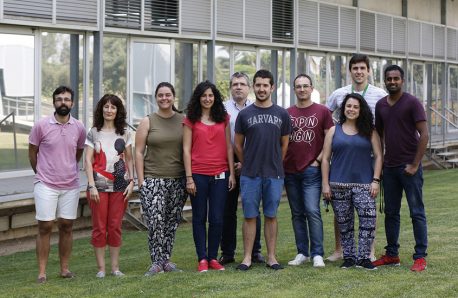Vidal
Research group

Abstract
Our past and current objectives encompass the Design of Efficient Enantioselective Catalysts for Transformations of Interest, and the study of their use to prepare enantiomerically pure products of biological, pharmaceutical or agrochemical interest. Crucial aspects of this work include modular design of the catalysts; use of versatile synthetic procedures (organic and inorganic transformations, or supramolecular processes); incorporation of regulation mechanisms for their active-site geometry; and computational study of their catalytic cycles (through collaborations).
We have two ongoing objectives: firstly, to develop new privileged structures in asymmetric catalysis (P−OP Ligands), using versatile covalent chemistry; and secondly, to generate a set of supramolecular catalysts that resemble a privileged structure and include the possibility of offering a range of closely related catalytic sites.
Topics addressed
- Supramolecularly regulated asymmetric catalysts.
- Highly modular P-OP ligands.
- Catalysis of industrial targets
Articles
“A Practical Synthesis of Rhodium Precatalysts for Enantioselective Hydrogenative Transformations”
Synthesis (2016) 48, 997-1001
B. Balakrishna, A. Vidal-Ferran
“Stereoselective Rh-Catalyzed Hydrogenative Desymmetrization of Achiral Substituted 1,4-Dienes”
Org. Lett. (2016) 18, 2836-2839
H. Fernández-Pérez, J. R. Lao, A. Vidal-Ferran
“Asymmetric Hydrogenation of Seven-membered C=N-containing Heterocycles and Rationalization of the Enantioselectivity”
Chem. Eur. J. (2016) 22, 10607-10613
B. Balakrishna, A. Bauzá, A. Frontera, A. Vidal-Ferran
“Supramolecularly Fine-regulated Enantioselective Catalysts”
Chem. Commun. (2016) 11038-11051
M. Vaquero, L. Rovira, A. Vidal-Ferran
“Palladium-Based Supramolecularly Regulated Catalysts for Asymmetric Allylic Substitutions”
Organometallics (2016) 35, 528-533
L. Rovira, H. Fernández-Pérez, A. Vidal-Ferran
“Correlation between the Selectivity and the Structure of an Asymmetric Catalyst Built on a Chirally Amplified Supramolecular Helical Scaffold”
J. Am. Chem. Soc. (2016) 138, 4908-4916
A. Desmarchelier, X. Caumes, M. Raynal, A. Vidal-Ferran, P. W. N. M. van Leeuwen, L. Bouteiller